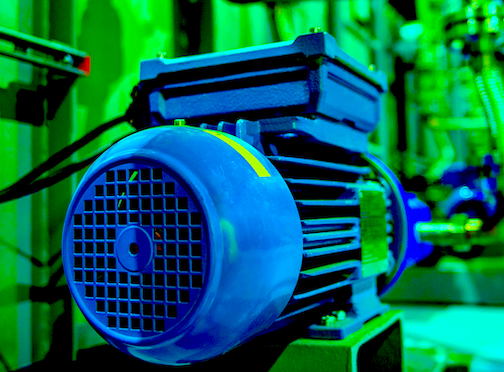From previous articles in this series on large-electric-motor studies conducted by EPRI and IEEE, we’ve noted the fact that there were potential issues with the findings, including in the area of industry best practices related to component replacement through repair. We’ve also identified the potential to significantly reduce failure rates and unplanned failures through proper methods appropriate for the types of failures at a site. Going forward, we will review the types of testing and inspections that can be performed for large electric motors. Among other things, we’ll explore the relevant tests and their capabilities, as well as a step-by-step process for selecting and implementing such testing and frequency. We’ll also examine the effective use of IoT (Internet of Things) capabilities in motor-system testing.
THE CHALLENGE
One of the biggest challenges in the area of motor testing has been the development of effective programs. By viewing issues from the component level, or from assumed failures, incorrect data would be captured resulting in unplanned outages. To perform actions that make sense, a review of the types of failures that have been occurring in the equipment (or similar equipment), including basic root-cause analysis (RCA) is required. In short, a little detective work up front can make the program far more effective than addressing issues based upon emotion or what an instrument vendor is telling you. Furthermore, taking a deeper look into reports from repair vendors, consider those where no problems were found. Was a bearing replaced just because it was removed from the motor? What did the testing data show?
In effect, a combination of what was found to be excellent maintenance by the referenced EPRI and IEEE studies has typically been presented as best practices. The most common methods seem to have been based on the concepts of mechanical and bearing failure as being the primary causes, with basic testing on the insulation system performed as a secondary method, if at all, and often monitored in terms of temperature. So, for example, when we look at most machines that are being monitored, we see overall vibration, temperature and over-current relays, and sometimes, a few other relays related to the machine. What all of these indicators have in common is that they show us conditions after a machine has technically failed, which often leaves us without the ability to mitigate the problem.
If we were, instead, to regularly perform root-cause analyses on failed (or failing) motors, we could start looking at the development of faults and identify testing methods to help identify and mitigate them. This is where the primary impact of a condition-based maintenance (CBM) program can truly begin (pay off).
The next step is to understand available technologies and frequency of required testing, and to also become familiar with some new and/or emerging technologies and the pros and cons for their selection. The end-goal for a plant or facility is to develop a testing program that provides a higher picture of the condition of it motor systems versus merely concentrating on one problem or type of test at a time.
CONSISTENCY IS KEY
Remember: The first rule in developing a motor-testing program is to ensure consistency. Once everything is relatively uniform, definitive patterns emerge. These patterns can be addressed through measurements to detect condition to more significant engineering changes to mitigate the patterns and failure rates.
Take, for example, an increase in temperature at a fault point due to friction or insulation-related problems, including loose connections, involves energy losses, meaning that you will see an overall drop in operating efficiency. These changes tend to occur once a fault is severe and, in many cases, involve a functional failure. Consider a 100-horsepower motor with a bearing-temperature increase of 5 C degrees: This motor could have a drop in efficiency of approximately 2%, with a resulting loss in the bearing of (100 hp * 0.02) * .746kW/hp = 1.49kW (approximately) that feeds increased friction and windage. Most diagnostic technologies would detect the fault well before there is a substantial increase in operating temperature that could simply point to identify a lubrication or alignment condition.
Voltage unbalance, circuit-impedance unbalance, loose connections, changes in load, increased friction, and a variety of other conditions can cause winding-temperature increases. If we have a machine trip due to a thermal increase without other data, considerable time can be lost troubleshooting while the equipment is unavailable or operating at risk for additional damage. Through the proper selection of technologies, we can detect the causes of these conditions even before a motor trips.
Keep in mind, however, that not all testing involves test equipment. Often, the best tests are visual or based on the use of other human senses. In fact, in most standards visual inspections are part of the testing process, and such tests should be considered both condition-based and pass-fail. For instance: even if insulation-resistance tests are high, but an insulation system is found to be dry, brittle, and cracking, the insulation system has failed.
COMING UP
In the next installment of this series, we will discuss high-voltage-testing prognostics, i.e, insulation to ground, high potential, and surge testing.TRR
Click the Following Links for Previous Articles In This Series on the Reliability of Large Electric Motors
March 28, 2020: “What The Studies Really Said”
April 12, 2020: “Comparing What The Studies Said”
April 18, 2020: “How The Studies Applied to Larger Motors”
May 2, 2020: “A Data Mind-Bender”
May 29, 2020: Site and Study Findings Compared
ABOUT THE AUTHOR
Howard Penrose, Ph.D., CMRP, is Founder and President of Motor Doc LLC, Lombard, IL and, among other things, a Past Chair of the Society for Reliability and Maintenance Professionals, Atlanta (smrp.org). Email him at howard@motordoc.com, or info@motordoc.com, and/or visit motordoc.com.
Tags: motors, drives, electrical systems, motor testing, reliability, availability, maintenance, RAM, EPRI, IEEE



